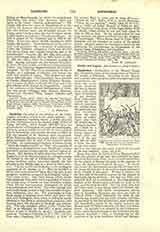

Candidus, the name of two scholars of the Carlovingian revival of letters in the ninth century. (I) The Benedictine Candidus Bruun of Fulda received his first instruction from the learned Aegil (Abbot of Fulda, 817-822); Abbot Ratger (802-817) sent the gifted scholar to Einhard at the court of Charlemagne, where he most probably learned the art he employed later in decorating with pictures the apse to which, in 819, the remains of St. Boniface were transferred. When Rabanus Maurus was made abbot (822) Candidus succeeded him as head of the monastic school of Fulda. As a philosopher Candidus is known by his “Dicta de imagine mundi” or “Del” (the question of authorship is decided by the Cod. Wirciburg.), twelve aphoristic sayings strung together without logical sequence. The doctrine is taken from the works of St. Augustine, but the frequent use of the syllogism marks the border of the age of scholasticism. In his last saying Candidus makes somewhat timidly the first attempt in the Middle Ages at a proof of God‘s existence. This has a striking similarity to the ontological argument of St. Anselm (q. v.—Man, by intellect a better and more powerful being than the rest, is not almighty; therefore a superior and almighty being—God—must exist). The third saying, which denies that bodies are true, since truth is a quality of immortal beings only, is based on that excessive realism which led his contemporary, Fredegisus, to invest even nothingness with being. The other sayings deal with God‘s image in man’s soul, the concepts of existence, substance, time, etc. The philosophy of Candidus marks a progress over Alcuin and gives him rank with Fredegisus, from whom he differs by rarely referring to the Bible in philosophical questions, thus keeping apart the domains of theology and philosophy. The only complete edition of the “Dicta Canidi” is in Haureau (p. 134-137); a more critical edition of part in Richter (p. 34 s q.). Candidus also wrote an “Expositio Passionis D. N. J. Chr.” (in Pez, Thes. anec., Augsburg, 1721, I, 241 sq.); a “Life” of his teacher Aegil in prose and in verse (Brouwer, “Sidera vir.”, Mainz, 1616, p. 19-44, Dummler, “Poetae lat. aevi caroling.”, Berlin, 1884, II, 94-117); and a “Life” of Abbot Baugolf of Fulda (d. 802).
(2) Candidus, name given to the Anglo-Saxon Wizo by Alcuin, whose scholar he was and with whom he went in 782 to Gaul. At the palace school he was tutor to Gisla, the sister, and Rodtruda, the daughter of Charlemagne. When Alcuin went to Tours (796), Candidus was his successor as master of the palace school. Alcuin‘s esteem for Candidus is shown by his dedicating his commentary on Ecclesiastes to his friends Onias, Fredegisus, and Candidus.
JOHN M. LENHART

